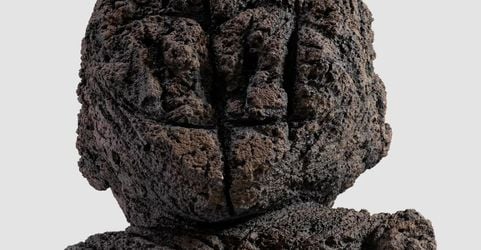David Zwirner is pleased to present concurrent exhibitions of work by Huma Bhabha (b. 1962) at the gallery's 537 West 20th Street and 34 East 69th Street locations in New York. These are the gallery's first presentations of Bhabha's work since the announcement of her representation in 2022, and they follow the artist's 2023 solo exhibition at M Leuven, Belgium, which recently traveled to MO.CO., Montpellier, France. In March 2024, three sculptures by Bhabha will be specially featured in the retrospective exhibition Julie Mehretu: Ensemble at Palazzo Grassi, Venice. In April 2024, a large-scale installation by Bhabha, commissioned by Public Art Fund, will be unveiled at Brooklyn Bridge Park, New York.
Bhabha creates layered and nuanced sculptures and drawings that center on a reinvention of the figure and its expressive possibilities. Her formally innovative practice pulls from a wide range of references, from those that span the history of art to quotidian influences such as science fiction and horror films and the makeshift structures and detritus of urban life. Instinctive and rigorous, her work brings diverse aesthetic, cultural, and psychological touchstones into contact with matters of surface, materiality, and formal construction. Featured at West 20th Street are new sculptures, varying in size from small to monumental; on view at East 69th Street are new works on paper and smaller-scale sculptures. Together, the exhibitions highlight Bhabha's ability to move between a wide range of media and forms, creating deeply resonant hybrid figures that seem to simultaneously dwell in the past, present, and future.
Further inside are two upright figures, Maybe Nothing Maybe Everything (2024) and Nothing Falls (2024), both cast in bronze. The former presents a multiheaded creature whose arms are pressed to its chest in prayer or panic. The latter takes the form of a rectangular earthen body that surges upward from the ground—reminiscent of the unshakable monolith from Stanley Kubrick's film 2001: A Space Odyssey (1968)—and pushes its bone-white skeletal head toward the open sky as if it is a holy relic or ritual sacrifice on a dais. As Bhabha evocatively describes, the work's contrasting geometric and organic forms resemble 'earth sculpted by wind and fire touching a cloud made of bone.'
These two sculptures flank the largest figure in the show, Even Stones Have Eyes (2023), which stands more than twelve feet tall. With its shadowy Januslike faces that have been etched, scarred, and seemingly charred, this peg-legged behemoth exudes a thrilling stillness and horror as it towers over its companions like a watchful parent surrounded by its brood. At once monstrous, animal, alien, and deeply human, Bhabha's totemic figures recall cycles of growth and decay, destruction and restoration, thereby challenging our understandings of permanence, monumentality, and personal and collective histories.
At the East 69th Street gallery, the cast-iron sculpture Waddah (2024) takes the form of a lone petrified human figure—devoid of a face or identifying features—that rests on a pedestal reminiscent of black earth. As with many of her recent sculptures, Bhabha considers the plinth to be an intrinsic part of the work, lending the overall arrangement the feeling of a mortal relic or an artifact from another world. The other sculpture on view, My Ancestor (2023), comprises a pair of amputated legs that have been sculpted out of porous cork and inscribed with lines of white chalk to resemble stump feet or cloven hooves. Hovering between states of ruin and repair, these sculptures appear either as bearers of the collective casualties forced on nature, or as signs of fresh life emerging from the earth. Juxtaposed with Waddah and My Ancestor is a suite of new works on paper, each one depicting a different head constructed from vibrant swaths and strokes of ink, acrylic, gouache, and pastel, as well as elements of collage. An enduring and crucial aspect of her practice, Bhabha's large-format multimedia drawings beckon the viewer with their exaggerated, ghoulish visages and unabashedly confrontational gazes.
Together, Bhabha's sculptures and works on paper are visibly marked by the human hand. With their rough-hewn surfaces, they appear to have emerged from a blasted landscape—like survivors of war, or perhaps prisoners returning home, acutely aware of those left behind. As curator Shanay Jhaveri writes, 'The artist's roving eye speaks volumes to a particular sensibility, one in which various aesthetic practices are in dialogue with one another.... There is a convergence of form and content in her work, coming from different places and histories, that seeks to question rather than affirm extant cultural dynamics.'
Press release courtesy David Zwirner
537 West 20th Street
New York, NY 10011
United States
www.davidzwirner.com
+1 212 517 8677
Tuesday – Saturday
10am – 6pm
